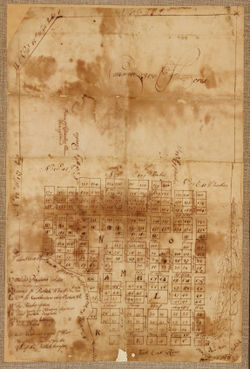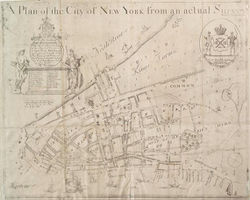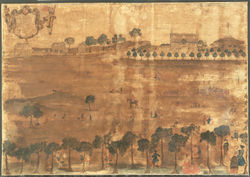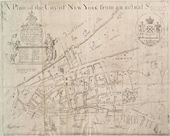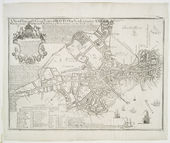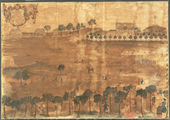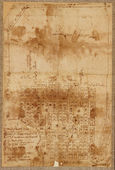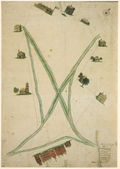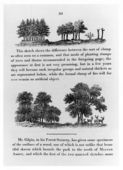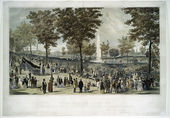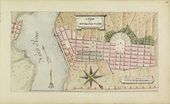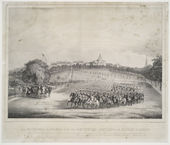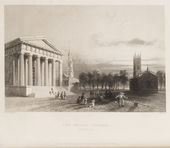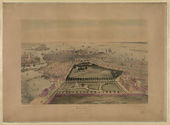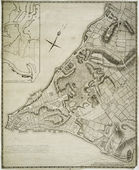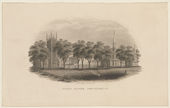Common
See also: Green, Mall, Park, Pleasure ground, Public ground, Square
History
Dictionary entries are succinct in their definitions of a common as open, shared land. G. (George) Gregory detailed the legal distinctions of various kinds of commons, but his specificity regarding the relationship of lords and commoners in the English legal system serves only to highlight the contrast between English and American contexts.[1]
In the American colonies, early land records used the phrase “common lands” to signify both ungranted, undeveloped land (sometimes called “Proprietor’s land”) and shared land that was used for pasture or agriculture.[2] In addition, the term was used to describe open spaces such as meeting house commons (or lots), although public gathering areas were also called squares and greens. For example, a plan of 1742 for Charlestown, Maryland [Fig. 1], depicts, in addition to the Market Place (at “M”), the Courthouse square (“L”), and two squares “for Meeting houses or other Publick Occasions” (“N” and ”O”), a Common of three hundred acres to the west of the settlement’s lots. Town commons were most frequently found in New England’s clustered and linear villages, where they were often models for subsequent settlement in the West.[3] Descriptions of commons are less frequently found in the mid-Atlantic and the South.
The particular form and function of the common land were integrally tied to the nucleated, linear, or dispersed settlement pattern of each town or village. Contrary to popular myths about the ideal 17th-century New England village—with its central green or common—the layout of towns or villages differed widely. Variations depended partly on the traditional models that immigrants brought with them from their countries or regions of origin, and partly on the environment and the economics of the local setting.[4] In some cases common lands were long, narrow lots (as in Springfield, Massachusetts), and in others large plots of land near the center were reserved as town property (as in Salem, Mass.).[5] In larger towns, commons set aside as public grazing space were often just outside the most densely settled areas, as indicated in maps of Charlestown, Boston [Fig. 2], and New York [Fig. 3]. In many cases, there was no centralized village, and the only commonly shared land was the meeting house lot. Boston Common was one of the earliest and largest commons, but others were established in Newport, Rhode Island (1713), Bristol, Rhode Island (1680),[6] and Savannah, Georgia (1733) [Fig. 4].
The early central town commons were used for burying grounds and grazing land, in some cases with a pen or “close” for enclosing animals brought in from pasture.[7] It has been suggested that in towns where the commons or greens were not regularly used for grazing, they still provided places to gather cattle in the event of Indian attack.[8] It also has been noted that in New England the areas that became the central village commons in the 19th century were (with the exception of Boston Common) not a part of the colonial common land for pasturage and cultivation but instead derived from the meeting house lot.[9]
As economies changed, so did the function of agricultural and pastoral common lands. In New England, shifts in the use of common land were caused by changes in farming techniques and land tenure systems, and also by tensions over land use rights between newcomers and descendants of original settlers.[10] During the 18th century the uses of town commons expanded to include pest houses for victims of infectious disease (as in Newburyport, Massachusetts), gun houses, and powder magazines. The open space was also a convenient stage for militia exercises and public gatherings of the citizenry, such as the fireworks display on Boston Common in 1765 or Joseph Pilmore’s preaching in 1770 to a crowd in Gloucester, New Jersey.
The American Revolution saw the disestablishment of church and town and, in New England, also saw the rise of the center village. This village type had a commercial core marked by a bounded corporate space (a green, common, or square) and surrounded by shops, a meeting house, and private dwellings [Fig. 5].[11] These commons came to be used primarily as recreational and social arenas. Their landscaping reflected that use, and the spaces became more like parks. As towns prospered and grew, they passed ordinances restricting livestock on commons and approved initiatives to fence, plant, and otherwise improve previously undeveloped commons. William Bentley’s ongoing observations (1801, 1802) of Salem Common (later Washington Square) offer a detailed view of the process of improvement of a town common, as well as a glimpse of some of the civic politics involved. He described subscription campaigns to raise funds, techniques to level the ground, the installation of decorative gates [Fig. 6], and also the conflicting claims by the militia and the town council about rights to the space. The landscape designs, however, for these late 18th- and early 19th-century commons remained fairly simple. Views from the 18th century, such as Christian Remick’s 1768 painting of British Troops on the Boston Common, show relatively sparse plantings with the exception of a double row of trees known as “The Mall,” shown in the foreground of the image. The layout, in Boston and in other locations, was often limited to a few simple paths or cart tracks with an ornamental gate or two to grace a well-railed or fenced boundary [Fig. 7].
In contrast, images of commons from the second quarter of the 19th century reveal complex circulation routes, tree-lined walks and avenues, ornamental iron fences, and, in the most elaborate examples, fountains made possible by the introduction of pressurized city water systems. John Warner Barber’s descriptions record how improvements (such as tree planting and digging ponds), even in smaller communities, were undertaken to enhance town commons [See Fig. 9]. Fencing and control of animals allowed for the development of grass lawns. At some sites, such as Salem Common and the New Haven Common (the latter was also called a green), the space was intentionally leveled to create a smoother terrain. Like squares and parks, commons in the 19th century continued to be important social gathering places and prominent stages for civic and patriotic celebrations.[12] Towns such as Lexington, Massachusetts, located battle monuments on their commons.[13] Like other open urban spaces, commons were lauded for their beneficial, healthful qualities; this interest in public health often involved relocating the colonial burying grounds within the boundaries of commons.
Unlike the term “square” or “park,” however, the reference to common seems to have had a particular association with the rural village. In 1802, at Salem, improvements such as grading and fencing led to the renaming of the Common as “Washington Square” to suit its new-found urban sophistication. The rural associations of the term were also valued by others. A. J. Downing's choice of the term “common” (rather than that of green, parade, or park) to describe an open green space in the middle of his plan for a suburban neighborhood implied a nostalgic harkening to a mythic age of rural village solidarity.[14]
—Elizabeth Kryder-Reid
Texts
Usage
- Anonymous, 1640 and 1646, describing Boston Common, Boston, MA (quoted in Adams 1842: 7)[15]
- “[March 1660] Hereafter there shall be no land granted either for house plot or garden to any person, out of the open ground or common field, which is left between the Sentry Hill and Mr. Colburn’s end. . .
- “[May 1646] No dry cattle, young cattle, or horse, shall be free to go on the Common this year but one horse of Elder Oliver.”
- Josselyn, John, 1674, describing Boston, MA (quoted in Reps 1965: 141)[16]
- “On the South there is a small but pleasant common, where the Gallants a little before Sunset walk with their Marmalet-Madams.”
- Anonymous, March 24, 1733, describing in the South Carolina Gazette the settlement of Savannah, GA (quoted in Reps 1965: 186)[17]
- “Mr. Oglethorpe is indefatigable. . . He was pallisading the town round, including some part of the common, which I do suppose may be finished in about a fortnight’s time.”
- Anonymous, May 19, 1776, describing in The Boston Gazette the Boston Common, Boston, MA (quoted in Brigham 1954: 21)[18]
- “[To] be exhibited on the Common, an Obelisk—A Description of which is engraved by Mr. Paul Revere; and is now selling by Edes & Gill.”
- Cutler, Manasseh, July 28, 1787, describing New York, NY (1987: 1:307)[19]
- “Broadway leads from the fort, or White Hall Square, to the common, and so out of the city through the Bowery. The common is considerably large, in a triangular form, and surrounded with buildings. On the northern side side of the Square are three very elegant large public buildings, which make a fine appearance at a distance, all built of free-stone, with a handsome fence inclosing a court-yard in front.”
- Morse, Jedidiah, 1789, describing New York, NY (1789; repr., 1970: 253)[20]
- “But the most convenient and agreeable part of the city is Broadway. This street runs upon the height of land between the two rivers, beginning at the fort near the south end of the city and extending to the Hospital, in front of which it opens into an extensive plain or common.”
- Bentley, William, 1801 and 1802, describing Salem Common (later Washington Square), Salem, MA (1962: 2:403, 428–29, 431)[21]
- “12. [November 1801] This day the ground was first broken on the Common for levelling [sic], & the filling of the northwest pond was begun. There is a great disposition to remove all public buildings & a vote favourable to the design has been obtained in a thin meeting. I see no necessity but rather admit the beauty of public buildings on open Squares. That the Common was appropriated at first for a training field is as good an objection to pleasure walks as to public buildings, as pleasure walks are not fitted for parades. . .
- “24. [April 1802] The levelling [sic] of the Common continues with advantage. The Trees are disposed so that the Elms should be 30 feet apart, & between them two Lombardy poplars.
- “May 1 [1802]. . . Mr. Timothy Hunt who has engaged to level the Common & has had great success, was one of the United Irishmen. . . He is to receive eleven hundred dollars & to find everything he may use. He employs from 12 to 15 hands & succeeds beyond all expectation. . .
- “18. [May 1802]. . . It is said that it is agreed to call the Common, which now is almost levelled [sic] & railled [sic], Washington Square. This is better than walking in common.
- “21. [May 1802] Mr. Hunt has succeeded in levelling the Common. The Subscription is not sufficient to answer all demands & is to be renewed. Col. Derby deserves all praise.
- “22. [May 1802] Subscription for elegant gates to the Washington Square, alias Common.” [See Fig. 6]
- Lambert, John, 1816, describing Savannah, GA (1816: 2:267)[22]
- “A large burying-ground is judiciously situated out of town, upon the common. It is inclosed by a brick wall, and contains several monuments and tomb-stones, which are shaded by willows and pride of India; and have a very pretty effect.”
- Anonymous, January 1, 1836, describing Boston Common, Boston, MA (Horticultural Register 2: 33)[23]
- “Apart from the beautiful scenery connected with these resorts [public walks in New York], or in themselves alone, they cannot compare with our fine Common, of which Bostonians deservedly pride themselves, and which at a little expense might be made one of the most splendid places of promenade in the country.”
- Alcott, William A., 1838, “Embellishment and Improvement of Towns and Villages” (American Annals of Education 8: 337–42)[24]
- “Of our larger cities, even Philadelphia and Boston, we do not hesitate to say that almost every thing, in their structure and condition, is at war with the highest physical and moral well being of their inhabitants. We do not indeed forget their beautiful commons and squares and public walks; but it is impossible for us to believe that a few of these will ever atone for that neglect whose effects stare us in the face, not merely in passing through dirty and filthy avenues, but in traversing almost every street, and in turning almost every corner. A single common, beautiful though it may be, as any spot on the earth’s surface, and refreshed though it were by the balmy breezes which ‘blow soft o’er Ceylon’s isle;’ or a few public squares, remembrancers though they be of him whose praises will never cease to be celebrated while the ‘city of brotherly love’ shall remain, will yet never purify the crowded, unventilated cellars and shops—and dwellings, too—of a hundred or a thousand thickly congregated streets. . .
- “We wish to see not only spacious squares or commons interspersed with shade, if not with fruit trees, in every village and town and city, but we wish to see public gardens on an extensive scale. We wish to see these not only for health’s sake, and for the sake of their moral tone and tendency, but as a means of rational amusement—as a means of promoting the public cheerfulness, the public taste, and of consequence, the public happiness.”
- Adams, Nehemiah, 1838, describing Portland, ME (Adams 1838: 35, 39–40)[25]
- “We feel sad at the sight of every tree that is taken away, without another being planted in its stead; though it is some consolation that the city, in some instances, has taken these alienated denizens of the vegetable kingdom under its own protection, and safely transplanted them to the Common. . .
- “The disposition of the trees on the Common is apt to strike one as too stiff and formal, for the greatest degree of beauty. The science of landscape gardening, our ignorance of which is so easily explained by the small amount of wealth with a comparatively new country can afford to devote to its practice, would have dictated differently. Had its principles been regarded, we should have seen trees of various foliage, here standing alone, and there intermingled in copses and groves— arranged, indeed, so as to imitate nature herself, in her picturesqueness as well as her beauty.”
- Buckingham, James Silk, 1841, describing Boston Common, Boston, MA (1841: 2:331)[26]
- “This Common, as it is called, or ‘The Park,’ as it might with propriety be designated, with the fine view of the surrounding country from its more elevated parts, and the noble trees and gravel-walks throughout, is only inferior in size and beauty to Hyde Park, Regent’s Park, and the Green Park in London; and is greatly superior to any similar enclosure in New-York, Philadelphia, or Baltimore. It covers an area of seventy-five acres, and has upward of 600 trees planted in it. The whole is enclosed with an ornamental iron fence or railing, which cost 90,000 dollars, or nearly £20,000. Within it is a fine sheet of water, surrounded with elms, called ‘The Crescent Pond’; and very near the centre of the whole are the remains or traces of a fortification, thrown up by the British troops who were stationed here in 1775.
- “The Common is surrounded on three of its sides by noble rows or terraces of houses, like the parks in London; and as it was originally granted for the public use, and any farther encroachment upon it rendered impossible by a clause in the last charter of the city, it is of the utmost value to the inhabitants. It is not merely a beautifully ornamental appendage to their noble city, but is used as a place of healthful and innocent recreation for all classes, as a spot of constant exercise and promenade; and it is impossible to witness its advantages without regretting that every town in England is not provided with a similar extent of public grounds for the delight and enjoyment of its population.”
- Adams, Nehemiah, 1842, describing Boston Common, Boston, MA (Adams 1842: 9, 11–12, 22, 28, 35, 51)[27]
- “Many, very many, in a great city, seldom see the arch of heaven. Even those who walk or ride for pleasure are often struck with the effect of a full view of the sky when they are out of the city. One of the great advantages of the Common is the unobstructed sight of the heavens above it. . .
- “Indeed it is seldom that a piece of ground is seen which, with no greater extent, is so diversified in surface and combines so much in itself that is picturesque, as the Common. There is hill and plain, meadow and upland, in it. It has sufficient irregularity to make a pleasing variety of surface without being rough; its elevations are well sloped towards the plain part of the enclosure; indeed it would be difficult for art to arrange the surface of the Common more agreeable for pleasing effect or use. . .
- “The Common with its malls for hoops, and ball, and marbles, and wicker carriages, its Frog Pond for boats and skating, its hills for coasting, its new cut grass, its training days and military parades, and fireworks, the governor taking his chair at ‘artillery election,’ and all its varied entertainments, contributes as largely as any place can do to the formation of those youthful impressions which make childhood happy, and the remembrances of it pleasant. . .
- “The Common with its varied surface is admirably fitted for military exhibitions. . .
- “One of the most interesting exhibitions that ever took place on the Common was that of the Indians of the Sacs and Fox, the Sioux and Iowa tribes, who visited us in the fall of 1837. They held a war dance on the Common in the presence of seventy thousand spectators. . .
- “The centre of the Common is obstructed by rows of young but thrifty and fast increasing trees. They were planted along the principal paths, for the benevolent purpose of affording shade to those who cross the Common. Their usefulness even in this respect is doubtful, and there is more than a doubt respecting their good influence upon the Common as a public ground. Our summers are so short, the air of the Common is generally so cool or in such good circulation, that the use of shaded walks through its centre is very small compared with the desirableness of having one large open place, as the Common has always been, in a crowded city. We do not need the whole Common as a mere parasol; its wide and free grounds and prospect are its chief beauty, and the shaded malls are sufficient as places of resort from the heat. . . There will soon be an end to great public exhibitions on the Common, if the trees now in the centre should thrive.”
- Dickens, Charles, 1842, describing Yale College, New Haven, CT (1842: 94)[28]
- “New Haven, known as the City of Elms, is a fine town. Many of its streets (as its alias sufficiently imports) are planted with rows of grand old elm-trees; and the same natural ornaments surround Yale College, an establishment of considerable eminence and reputation. The various departments of this Institution are erected in a kind of park or common in the middle of the town, where they are dimly visible among the shadowing trees. The effect is very like that of an old cathedral yard in England; and when their branches are in full leaf, must be extremely picturesque.”
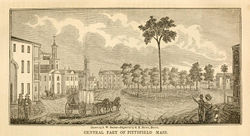
- Barber, John Warner, 1844, describing Pittsfield, MA (1842: opp. 87)[29]
- “This view shows the appearance of the Common, as seen from near the western side. The Congregational Church is the first building, with a spire, on the left; the next the Town-House; the next eastward is the Episcopal Church; the other buildings near are connected with the Medical Institution. The ancient elm, one hundred and twenty-six feet in height, is seen rising in the central part of the Common.” [Fig. 9]
- Barber, John Warner, 1844, describing Westfield, MA (1844: 301)[29]
- “A small enclosed common, oval in its form, is in the central part of the area, around which the public buildings are situated; it is newly set out with shade trees, and will add to the beauty of the place.” [Fig. 10]
- Tuthill, Louisa C. (Louisa Caroline), 1848, describing Boston Common, Boston, MA ([1848; repr., 1988: 318)[30]
- “The Boston Common is the most spacious public pleasure-ground in the United States. Seventy-five acres were appropriated by the early ‘fathers of the town’ to this purpose, on the condi.tion that it should ever remain devoted in this way to public convenience and comfort. The same venerable elms which shaded the patriots of the Revolution, still wave over the heads of their successors, and fresh young trees are planted from year to year by the side of the new-gravelled walks, rendered necessary by the rapidly increasing population of the city. The undulating ground of the Common gives it a pleasing diversity of hill and vale, and the little lake or pond near the centre, adds to its picturesque beauty.”
- Jaques, George, February 1851, describing the planting of trees in Boston Common, Boston, MA (Magazine of Horticulture 17: 50–52)[31]
- “I propose, at present, to speak first of planting trees upon side-walks. In American cities, it is customary to construct streets with a wide carriageway in the middle, and a walk for pedestrians on either side. Trees are usually planted on the line between these foot-walks and the carriageway. . .
- “Take as an example Boston Common. Here we have, for the most part, a smooth grass surface, intersected by straight wide gravel-walks, and these lined on each side with trees placed along at equal distances form each other. But suppose no tree or walk were there, and a carte blanche were given to any one that he might arrange all things to his own fancy, what would you do, Mr. Editor? Would you plant straight rows of equidistant trees there? Probably not. For, although such an arrangement of fruit or shade trees may be in its place very convenient and useful, it can never please the eye which admires the picturesque beauty of trees growing in groups.”
Citations
- Johnson, Samuel, 1755, A Dictionary of the English Language (1755: 1:n.p.)[32]
- “COMMON. n.s. [from the adjective.] An open ground equally used by many persons.”
- Gregory, G. (George), 1816, A New and Complete Dictionary of Arts and Sciences (1816: 1:n.p.)[33]
- “COMMON, is a right or privilege which one or more persons claim to take or use, in some part or portion of that, which another man’s lands, waters, woods, &c. naturally produce; without having an absolute property in such lands, woods, waters, &c. 2 Inst. 65.
- “The general divisions of common are, into common of pasture, which is a right of liberty that one or more have to feed or fodder their beasts or cattle in another man’s land. . . 1 Bac. Abr. 385.
- “But the word common is usually understood of common of pasture.”
- Downing, Andrew Jackson, June 1850, “Our Country Villages” (Horticulturist 4: 540)[34]
- “The indispensable desiderata in rural villages of this kind [newly planned in the suburbs of a great city], are the following: 1st, a large open space, common, or park, situated in the middle of the village—not less than 20 acres; and better, if 50 or more in extent. This should be well planted with groups of trees, and kept as a lawn. The expense of mowing it would be paid by the grass in some cases; and in others a considerable part of the space might be enclosed with a wire fence, and fed by sheep or cows, like many of the public parks in England.
- “This park would be the nucleus or heart of the village, and would give it an essentially rural character. Around it should be grouped all the best cottages and residences of the place; and this would be secured by selling no lots fronting upon it of less than one-fourth of an acre in extent.”
Images
Inscribed
Pierre Pharoux, Plan of Esperanza, NY [detail], n.d.
Christian Remick, A Prospective View of part of the Commons, c. 1768.
Sydney L. Smith (engraver) from a watercolor drawing by Christian Remick (c. 1768), A Prospective View of part of the Commons, 1902.
Humphry Repton, Sketch of Planting Clumps, in Observations on the Theory and Practice of Landscape Gardening (1805), 50.
John Warner Barber, “Southern view in the central part of Westfield,” in Historical Collections (1844), 301.
Benjamin Franklin Smith Jr., View of the Water Celebration, on Boston Common October 25th 1848, 1849.
Associated
Pierre Pharoux, Plan of Esperanza, 1794, Architectural drawings and maps of Pierre Pharoux, HM 2028.
Pierre Pharoux, Plan of Courthouse Square in Esperanza, Architectural drawings and maps of Pierre Pharoux, 1795, HM 2028.
John Warner Barber, “The Lower Green, or Military Common, Newark, N.J.,” in Historical Collections (1844), pl. opp. 176.
John Warner Barber, “South-west view in Ipswich, (central part.),” in Historical Collections (1844), 192.
John Bachmann, Bird’s Eye View of Boston, c. 1850
Attributed
Anonymous, Court House Square, Warrenton, 1800.
L. S. Punderson, Public Square, New Haven, Ct., 1862.
Notes
- ↑ The history of American commons is only one aspect of the much larger history of colonial settlement and land use, town planning, and urbanization. This essay touches upon only those aspects of commons directly related to landscape design.
- ↑ Winifred Barr Rothenberg, From Market-Places to a Market Economy: The Transformation of Rural Massachusetts, 1750–1850 (Chicago: University of Chicago Press, 1992), 49–50, view on Zotero.
- ↑ Joseph S. Wood, The New England Village (Baltimore: Johns Hopkins University Press, 1997), 130, view on Zotero.
- ↑ On the variability of 17th-century New England settlement patterns, see Joseph S. Wood, “Village and Community in Early Colonial New England,” in Material Life in America, 1600–1800, ed. Robert Blair St. George (Boston: Northeastern University Press, 1988), 159–69, view on Zotero, as well as Wood 1997, view on Zotero; David D. Brodeur, “Evolution of the New England Town Common, 1630–1966,” The Professional Geographer 19 (November 1967): 313–18, view on Zotero; John D. Cushing, “Town Commons in New England, 1640–1840,” Old Time New England 51, no. 3 (winter 1961): 86–94, view on Zotero; John B. Meyer “The Village Green Ensemble in Northern Vermont,” Vermont Geographer 2 (1975): 21–42, view on Zotero. In addition, John Stilgoe has pointed out the suitability of common land to the Puritan’s community-based religion. See Stilgoe, “Town Common and Village Green in New England: 1620–1981,” in On Common Ground: Caring for Shared Land from Town Common to Urban Park, ed. Ronald Lee Fleming and Lauri A. Halderman (Cambridge, MA: Harvard Common Press, 1982), 9–10, view on Zotero.
- ↑ John William Reps, The Making of Urban America: A History of City Planning in the United States (Princeton, NJ: Princeton University Press, 1965), 125, view on Zotero.
- ↑ Donald Simon, “Green-Wood Cemetery and the American Park Movement,” in Essays in the History of New York City: A Memorial to Sidney Pomerantz, ed. Irwin Yellowitz (Port Washington, NY: Kennikat, 1978), 62, view on Zotero; “Rhode Island Landscape Survey: Pre-1850 Designed Landscapes,” manuscript on file, State of Rhode Island and Providence Plantations, Historical Preservation & Heritage Commission.
- ↑ John R. Stilgoe, Common Landscape of America, 1580–1845 (New Haven, CT: Yale University Press, 1982), 12, view on Zotero.
- ↑ Reps 1965, 124, view on Zotero.
- ↑ Wood 1997, 128–29, view on Zotero.
- ↑ Stilgoe 1982, 13–15, view on Zotero.
- ↑ Wood 1988, 167, view on Zotero, and Wood 1997, 88–113, view on Zotero.
- ↑ Even the earliest commons were also used for recreation, as John Josselyn’s description of Boston in 1674 attests. See Josselyn, An Account of Two Voyages to New England (London: Printed for G. Widdows, 1674), view on Zotero, and Reps 1965, view on Zotero.
- ↑ Stilgoe 1982, 25–26, view on Zotero.
- ↑ For a deconstruction of the New England village myth, see Russell Handsman, “Early Capitalism and the Center Village of Canaan, Connecticut: A Study of Transformations and Separations,” Artifacts 9, no. 3 (summer 1981): 1–22, view on Zotero.
- ↑ Nehemiah Adams, Boston Common (Boston: William D. Ticknor and H. B. Williams, 1842), view on Zotero.
- ↑ John Josselyn, An Account of Two Voyages to New England (London: Printed for G. Widdows, 1674), view on Zotero.
- ↑ John W. Reps, The Making of Urban America: A History of City Planning in the United States (Princeton, NJ: Princeton University Press, 1965), view on Zotero.
- ↑ Clarence Brigham, Paul Revere’s Engravings (Worcester, MA: American Antiquarian Society, 1954), view on Zotero.
- ↑ William Parker Cutler, Life, Journals, and Correspondence of Rev. Manasseh Cutler, LL.D. (Athens: Ohio University Press, 1987), view on Zotero.
- ↑ Jedidiah Morse, The American Geography; Or, A View of the Present Situation of the United States of America (1789; repr., Elizabeth Town, NJ: Shepard Kollock, 1789), view on Zotero.
- ↑ William Bentley, The Diary of William Bentley, D.D., Pastor of the East Church, Salem, Massachusetts (Gloucester, MA: Peter Smith, 1962), view on Zotero.
- ↑ John Lambert, Travels through Canada, and the United States of North America in the Years 1806, 1807, and 1808, 2 vols. (London: Baldwin, Cradock, and Joy, 1816), view on Zotero.
- ↑ Anonymous, “Leaves from My Note Book,” Horticultural Register, and Gardener’s Magazine 2 (January 1, 1836): 29–33, view on Zotero.
- ↑ William A. Alcott, “Embellishment and Improvement of Towns and Villages,” American Annals of Education 8, no. 8 (August 1838): 337–47, view on Zotero.
- ↑ Nehemiah Adams, The Boston Common, or Rural Walks in Cities (Boston: George W. Light, 1838), view on Zotero.
- ↑ James Silk Buckingham, America, Historical, Statistic, and Descriptive, 2 vols. (New York: Harper, 1841), view on Zotero.
- ↑ Nehemiah Adams, Boston Common (Boston: William D. Ticknor and H. B. Williams, 1842), view on Zotero.
- ↑ Charles Dickens, American Notes (Paris: Baudry’s European Library, 1842), view on Zotero.
- ↑ 29.0 29.1 John Warner Barber, Historical Collections, Being a General Collection of Interesting Facts, Traditions, Biographical Sketches, Anecdotes, &c., Relating to the History and Antiquities of Every Town in Massachusetts, with Geographical Descriptions (Worcester, MA: Warren Lazell, 1844), view on Zotero.
- ↑ Louisa C. Tuthill, History of Architecture, from the Earliest Times; Its Present Condition in Europe and the United States; with a Biography of Eminent Architects, and a Glossary of Architectural Terms, by Mrs. L. C. Tuthill (1848; repr., Philadelphia: Lindsay and Blakiston, 1988), view on Zotero.
- ↑ George Jaques, “Trees in Cities,” Magazine of Horticulture, Botany, and All Useful Discoveries and Improvements in Rural Affairs 17, no. 2 (February 1851): 50−52, view on Zotero.
- ↑ Samuel Johnson, A Dictionary of the English Language: In Which the Words Are Deduced from the Originals and Illustrated in the Different Significations by Examples from the Best Writers, 2 vols. (London: W. Strahan for J. and P. Knapton, 1755), view on Zotero.
- ↑ George Gregory, A New and Complete Dictionary of Arts and Sciences, 1st American ed., 3 vols. (Philadelphia: Isaac Peirce, 1816), view on Zotero.
- ↑ Andrew Jackson Downing, “Our Country Villages,” Horticulturist and Journal of Rural Art and Rural Taste 4, no. 12 (June 1850): 537–41, view on Zotero.
